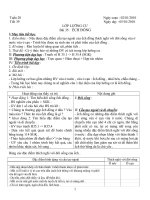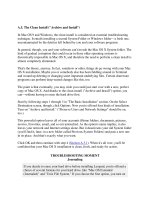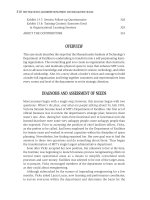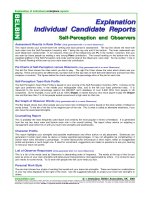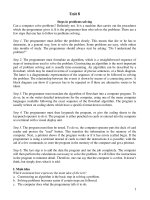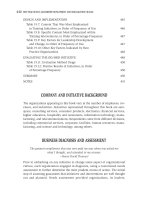Tài liệu Prolog Experiments in Discrete Mathematics, Logic, and Computability pdf
Bạn đang xem bản rút gọn của tài liệu. Xem và tải ngay bản đầy đủ của tài liệu tại đây (1.32 MB, 158 trang )
Copyright © 2009 by James L. Hein. All rights reserved.
Prolog Experiments in
Discrete Mathematics,
Logic, and Computability
James L. Hein
Portland State University
March 2009
2
Contents
Preface 4
1 Introduction to Prolog 5
1.1 Getting Started 5
1.2 An Introductory Example 6
1.3 Some Programming Tools 9
2 Beginning Experiments 12
2.1 Variables, Predicates, and Clauses 12
2.2 Equality, Unification, and Computation 16
2.3 Numeric Computations 19
2.4 Type Checking 20
2.5 Family Trees 21
2.6 Interactive Reading and Writing 23
2.7 Adding New Clauses 25
2.8 Modifying Clauses 27
2.9 Deleting Clauses 28
3 Recursive Techniques 31
3.1 The Ancester Problem 31
3.2 Writing and Summing 33
3.3 Switching Pays 36
3.4 Inductively Defined Sets 38
4 Logic 42
4.1 Negation and Inference Rules 42
4.2 The Blocks World 44
4.3 Verifying Arguments in First-Order Logic 46
4.4 Equality Axioms 48
4.5 SLD-Resolution 49
4.6 The Cut Operation 51
5 List Structures 54
5.1 List and String Notation 54
5.2 Sets and Bags of Solutions to a Query 56
5.3 List Membership and Set Operations 60
5.4 List Operations 64
Contents 3
6 List Applications 68
6.1 Binary Trees 68
6.2 Arranging Objects 70
6.3 Simple Ciphers 73
6.4 The Birthday Problem 76
6.5 Predicates as Variables 77
6.6 Mapping Numeric Functions 79
6.7 Mapping Predicates 80
6.8 Comparing Numeric Functions 83
6.9 Comparing Predicates 84
7 Languages and Expressions 86
7.1 Grammar and Parsing 86
7.2 A Parsing Macro 87
7.3 Programming Language Parsing 89
7.4 Arithmetic Expression Evaluation 90
8 Computability 94
8.1 Deterministic Finite Automata 94
8.2 Nondeterministic Finite Automata 96
8.3 Mealy Machines 99
8.4 Moore Machines 102
8.5 Pushdown Automata 104
8.6 Turing Machines 106
8.7 Markov Algorithms 110
8.8 Post Algorithms 112
9 Problems and Projects 116
9.1 Lambda Closure 116
9.2 Transforming an NFA into a DFA 118
9.3 Minimum-State DFA 124
9.4 Defining Operations 128
9.5 Tautology Tester 130
9.6 CNF Generator 134
9.7 Resolution Theorem Prover for Propositions 135
10 Logic Programming Theory 140
10.1 The Immediate Consequence Operator 140
10.2 Negation as Failure 141
10.3 SLDNF-Resolution 143
Answers to Selected Experiments 145
Index 156
4
Preface
This book contains programming experiments that are designed to reinforce
the learning of discrete mathematics, logic, and computability. Most of the
experiments are short and to the point, just like traditional homework
problems, so that they reflect the daily classroom work. The experiments in
the book are organized to accompany the material in Discrete Structures, Logic,
and Computability, Third Edition, by James L. Hein.
In traditional experimental laboratories, there are many different tools
that are used to perform various experiments. The Prolog programming
language is the tool used for the experiments in this book. Prolog has both
commercial and public versions. The language is easy to learn and use
because its syntax and semantics are similar to that of mathematics and
logic. So the learning curve is steep and no prior knowledge of the language is
assumed. In fact, the experiments are designed to introduce language features
as tools to help explore the problems being studied.
The instant feedback provided by Prolog’s interactive environment can
help the process of learning. When students get immediate feedback to
indicate success or failure, there is a powerful incentive to try and get the
right solution. This encourages students to ask questions like, “What happens
if I do this?” This supports the idea that exploration and experimentation are
keys to learning.
The book builds on the traditional laboratory experiences that most
students receive in high school science courses. i.e., experimentation,
observation, and conclusion. Each section contains an informal description of
a topic—with examples as necessary—and presents a list of experiments to
perform. Some experiments are simple, like using a program to check answers
to hand calculations, and some experiments are more sophisticated, like
checking whether a definition works, or constructing a small program to
explore a concept.
5
1
Introduction to Prolog
The Prolog language allows us to explore a wide range of topics in discrete
mathematics, logic, and computability. Prolog’s powerful pattern-matching
ability and its computation rule give us the ability to experiment in two
directions. For example, a typical experiment might require a test of a
definition with a few example computations. Prolog allows this, as do all
programming languages. But the Prolog computation rule also allows a
definition to be tested in reverse, by specifying a result and then asking for
the elements that give the result. From a functional viewpoint this means
that we can ask for domain elements that map to a given result.
After a brief introduction to Prolog we’ll start right in doing experiments.
To keep the emphasis on the discrete mathematics, logic, and computability,
we’ll introduce new Prolog tools in the experiments where they are needed.
1.1 Getting Started
This section introduces a few facts to help you get started using Prolog. To
start the Prolog interpreter in a UNIX environment type prolog (or sicstus for
those using SICStus Prolog) and hit return. Once Prolog has started up it
displays the prompt
|?-
which indicates that the interpreter is waiting for a command from the user.
All commands must end with a period. For example, the command
|?- integer(3.4).
returns the answer no because 3.4 is not an integer. A command is usually
called a goal or a query. To exit the interpreter type control D—press the
6 Prolog Experiments
control key and the D key at the same time.
Before we go any further, we’re going to go through an introductory
example to get the look and feel of Prolog. After the example, we’ll present
some useful programming tools.
1.2 An Introductory Example
A Prolog program is a set of facts or rules called definite clauses. We’ll usually
refer to them as clauses. The example program that follows describes some
family relationships. We’ll use the predicates “par” and “grand” with the
following meanings.
par(X, Y) means that X is a parent of Y.
grand(X, Y) means that X is a grandparent of Y.
Now we’ll list the program, which consists of some parent facts together with
a rule that defines the grandparent relationship in terms of parents. Note
that a comment is signified by the character % followed by any sequence of
characters up to the end of the line. Another way to comment is to place any
sequence of characters, including new lines, between the symbols /* and */.
% Here is a set of facts describing parental relationships.
par(lloyd, james).
par(lloyd, janet).
par(ruth, james).
par(ruth, janet).
par(emma, lloyd).
par(katherine, ruth).
par(adolph, lloyd).
par(edgar, ruth).
% The grandparent relationship. Any rule of the form
% A :- B, C is read, “A is true if B is true and C is true.”
grand(X, Z) :- par(Y, Z), par(X, Y).
Now, suppose that you have entered this program into a file named
familyTree. To read in the program type the following command.
|?- [familyTree].
Once the program has been read in it won’t do anything until it is presented
with a goal. We’ll give some example goals that ask questions about children
and grandparents.
Introduction to Prolog 7
Finding the Children of a Person
Suppose that we want to find the children of ruth. We can find them by typing
the following goal, where the letter C stands for a variable.
|?- par(ruth, C).
Prolog will search the program statements from top to bottom until it can
match the goal with some fact or the left part of a rule. In this case, the goal
matches par(ruth, james) by identifying C with james. Prolog responds with
C = james ?
At this point, we can hit return and Prolog will answer
Yes.
But if we hit a semicolon followed by return, then Prolog will backtrack and
continue to search for another match for the goal par(ruth, C). The goal
matches par(ruth, janet) by identifying C with janet. Prolog responds with
C = janet ?
If we hit a semicolon followed by return, then Prolog will continue to search for
another match. It doesn’t find any and lets us know with the statement
no.
So we can conclude that the two children of ruth are james and janet.
Finding the Grandparents of a Person
Suppose that we want to find all the grandparents of james. In this case, we
can enter the goal
|?- grand(A, james).
Prolog matches this goal with grand(X, Z) in the rule
grand(X, Z) :- par(Y, Z), par(X, Y).
It identifies X with A and Z with james. Now Prolog attempts to find matches
for the two goals on the right side of the grandparent rule:
par(Y, james) and par(A, Y).
8 Prolog Experiments
It tries par(Y, james) first, and finds a match with par(lloyd, james) by
identifying Y with lloyd. With this identification it tries to find a match for
the second goal par(A, lloyd). This goal matches the fact par(emma, lloyd) by
identifying A with emma. So Prolog outputs the answer
A = emma?
If we hit semicolon followed by return, then Prolog will try to find another
match for the goal par(A, lloyd). This goal matches the fact par(adolph, lloyd)
by identifying A with adolph. So Prolog outputs the answer
A = adolph?
If we hit semicolon followed by return, then Prolog will not find another match
for the goal par(A, lloyd). So it will backtrack and try to find a different match
for the first of the two goals
par(Y, james) and par(A, Y).
The goal par(Y, james) matches the fact par(ruth, james) by identifying Y with
ruth. With this identification it tries to find a match for the second goal par(A,
ruth). This goal matches the fact par(katherine, ruth) by identifying A with
katherine. So Prolog outputs the answer
A = katherine?
If we hit semicolon followed by return, then Prolog will try to find another
match for the goal par(A, ruth). This goal matches the fact par(edgar, ruth) by
identifying A with edgar. So Prolog outputs the answer
A = edgar?
If we hit semicolon followed by return, then Prolog will not find another match
for the goal par(A, ruth). When it backtracks, it won’t find any new matches
for the goals par(Y, james) and par(A, Y). So it backtracks to the original goal
grand(A, james). There are no other matches for this goal, so Prolog outputs
the answer
no.
Thus the four grandparents of james are emma, adolph, katherine, and edgar.
Introduction to Prolog 9
1.3 Some Programming Tools
We’ll record here several Prolog programming tools that should prove useful in
doing the experiments.
Loading Information
To read in the contents of a file named filename type
|?- [filename].
and hit return. If the file name contains characters other than letters or digits,
then put single quotes around the filename. For example, if the name of the
file is file.p, then type
|?- [‘file.p’].
will load the file named file.p.
You can read in several files at once. For example, to read in files named
foo, goo, and moo type
|?- [foo, goo, moo].
Sometimes it may be useful to enter a few clauses directly from the a
terminal to test something or other. In this case you must type the command
|?- [user].
and hit return. The prompt
|
will appear to indicate that the interpreter is waiting for data. To exit the
entry mode type Control D, which we’ll signify by writing ^D. For example, to
enter the two statements p(a, b) and q(X, Y) :- p(X, Y) type the following
statements.
|?- [user].
| p(a, b).
| q(X, Y) :- p(X, Y).
|^D
10 Prolog Experiments
Listing Clauses
To list the clauses of a Prolog program type the command
|?- listing.
To list only clauses beginning with predicate p type the command
|?- listing(p).
To list clauses beginning with predicates p, q, and r type the command
|?- listing([p, q, r]).
Using Unix Commands
To execute UNIX commands from SICStus Prolog, first load the system
library package with the command
|?- use_module(library(system)).
This goal can be automatically loaded and executed by placing the following
command in the .sicstusrc file.
:- use_module(library(system)).
Then UNIX commands can be executed using the system predicate. For
example, to edit the file named filename with the vi editor, type
|?- system(‘vi filename’).
Tracing Note
To interactively trace each step of a computation type the trace command.
|?- trace.
Now the execution of any goal will stop after each step. The names of the
computation steps are from the set {call, exit, redo, fail}. To continue the
computation you must react in one of several ways. For example, here are
some of the options that are available.
Introduction to Prolog 11
To “creep” to the next step hit return.
To “leap” to the end of the computation, type l and hit return.
To list the menu of available options type h and hit return.
You can switch off tracing by typing the notrace command.
|?- notrace.
Spying Note
It is usually not necessary to creep through every execution step of a program.
Spy-points make it possible to stop the execution at predicates of your choice.
For example, to stop the execution at each use of the predicate p, type the goal
|?- spy p.
You can set more than one spy-point. For example, if you want to set spy-
points for predicates p, q, and r, type the goal
|?- spy [p, q, r].
Now you can “leap” between uses of spy-points or you can still creep from step
to step. To “leap” to the next use of a spy-point, type l and hit return.
You can remove spy-points too. For example, to remove p as a spy-point,
type the nospy goal
|?- nospy p.
To remove p, q, and r as spy-points type the goal
|?- nospy [p, q, r].
To remove all spy-points type the goal
|?- nospyall.
12
2
Beginning Experiments
This chapter contains some simple experiments that are designed to
introduce some of the basic ideas of programming in Prolog.
2.1 Variables, Predicates, and Clauses
In this experiment we’ll see how to represent variables, predicates, clauses,
and goals. We’ll also introduce the computation rule used to execute Prolog
programs.
Variables
A variable may be represented by a string of characters made up of letters or
digits or the underscore symbol _, and that begins with either an uppercase
letter or _. For example, the following strings denote variables:
X, Input_list, Answer, _,
A variable name that begins with the underscore symbol represents an
unspecified (or anonymous) variable.
Predicates
A predicate is a relation. In Prolog the name of a predicate is an alphanumeric
string of characters (including _) that begins with a lowercase letter. For
example, we used the predicate “par” in the introductory example to denote
the “is parent of” relation. The number of arguments that a predicate has is
called the arity of the predicate. For example, par has arity 2. If a predicate q
has arity n, then we sometimes write q/n to denote this fact. For example,
Beginning Experiments 13
par/2 means that par is a predicate of arity 2.
An expression consisting of a predicate applied to arguments is called an
atomic formula Atomic formulas are the building blocks of Prolog programs.
For example, the following expressions are atomic formulas.
p(a, b, X),
capital_of(salem, oregon).
Clauses
The power of Prolog comes from its ability to process clauses. A clause is a
statement taking one of the forms
head.
or
head :- body.
where head is an atomic formula and body is a sequence of atomic formulas
separated by commas. For example, the following statements are clauses.
capital–of(salem, oregon).
q(b).
p(X) :- q(X), r(X), s(X).
The last clause has head p(X) and its body consists of the atomic formulas
q(X), r(X), and s(X).
Now let’s look at the meaning that Prolog gives to clauses. The meaning
of a clause of the form
head.
is that head is true. A clause of the form
head :- body.
has a declarative meaning and a procedural meaning. The declarative
meaning is that the head is true if all of the atomic formulas in the body are
true. The procedural meaning is that for head to succeed, each atomic formula
in the body must succeed. For example, suppose we have the clause
p(X) :- q(X), r(X), s(X).
From the declarative point of view this means that
for all X, p(X) is true if q(X) and r(X) and s(X) are true.
14 Prolog Experiments
From the procedural point of view this means that for all X, p(X) succeeds if
q(X), r(X), and s(X) succeed.
Or Clauses
Prolog also allows us to represent the “or” operation in two different ways. For
example, suppose that we have the following two Prolog clauses to define the
parentOf relation in terms of the motherOf and fatherOf relations.
parentOf(X, Y) :- motherOf(X, Y).
parentOf(X, Y) :- fatherOf(X, Y).
We can think of the two clauses as having the following form.
c :- a.
c:- b.
From a logical viewpoint, these two clauses represent the conjunction of two
conditionals of the following form.
(a → c) ∧ (b → c).
Now recall that the following equivalence holds.
(a → c) ∧ (b → c) ≡ a ∨ b → c.
The right side of the equivalence can be represented in Prolog as the following
or-clause, where the semi-colon denotes disjunction.
c :- a;b.
For example, the original two clauses that we used to define the parentOf
relation can also be expressed as the following or-clause.
parentOf(X, Y) :- motherOf(X, Y) ; fatherOf(X, Y).
Experiments to Perform
1. Input the program consisting of the two clauses p(a) and p(b). Then ask
the following questions:
|?- p(a).
|?- p(b).
|?- p(c).
Beginning Experiments 15
Use backtracking to find all possible answers to the following question.
|?- p(X).
2. Input the single clause q(_). Then ask the following questions:
|?- q(a).
|?- q(b).
|?- q(c).
Describe what happens when you try to find all possible answers to the
following question.
|?- q(X).
3. Input the following three clauses.
r(a).
r(b).
s(X) :- r(X).
Now ask the following questions:
|?- s(a).
|?- s(b).
|?- s(c).
Use backtracking to find all possible answers to the following questions.
|?- s(A).
|?- r(A).
4. Verify that the conjunction of clauses with the same head can be
represented by a single clause using the “or” construction by doing the
following tests. For each input the given data and then ask the question
|?- p(a).
Perform each test separately with only the given clauses as input.
a. p(b). b. p(c).
p(a) :- p(b). p(a) :- p(b).
p(a) :- p(c). p(a) :- p(c).
c. p(b). d. p(c).
p(a) :- p(b) ; p(c). p(a) :- p(b) ; p(c).
16 Prolog Experiments
2.2 Equality, Unification, and Computation
Most of us will agree that any object is equal to itself. For example, b is equal
to b, and p(c) is equal to p(c). We might call this “syntactic equality.” It’s the
most basic kind of equality and Prolog represents it with the following
symbol.
==
For example try out the following goals.
|?- b == b.
|?- p(a) == p(a).
|?- p(X) == p(b).
|?- 5 == 5.
|?- 2 + 3 == 1 + 4.
The expressions 2 + 3 and 1 + 4 are not syntactically equal, but they both
denote the number 5. This might be called “numerical” or “semantic equality.”
Prolog represents this equality with the following symbol.
=:=
For example try out the following goals.
|?- b =:= b.
|?- p(a) =:= p(a).
|?- p(X) =:= p(b).
|?- 5 =:= 5.
|?- 2 + 3 =:= 1 + 4.
What about expressions like p(X) and p(b)? They are not syntactically equal
and they are not semantically equal. But if we consider X to be a variable,
then we can say p(X) and p(b) are equal under the assumption that X stands
for b. This is an example of “unification” and it is a basic ingredient in the
matching process used for computation in logic programming.
Unification
Unification is the process of matching two expressions by attempting to
construct a set of bindings for the variables so that when the bindings are
applied to the two expressions, they become syntactically equal. Unification is
Beginning Experiments 17
used as part of Prolog’s computation rule. The following symbol is used for
unification within a program.
=
If two expressions can be unified, then Prolog will return with corresponding
bindings for any variables that occur in the expressions. For example, try out
the following tests.
|?- b = b.
|?- p(a) = p(a).
|?- p(X) = p(b).
|?- 5 = 5.
|?- 2 + 3 = 1 + 4.
Computation
A Prolog program executes goals, where a goal is the body of a clause. In other
words, a goal is one or more atomic formulas separated by commas. The
atomic formulas in a goal are called subgoals. For example, the following
expression is a goal consisting of two subgoals.
|?- par(X, james), par(Y, X).
The execution of a goal proceeds by unifying the subgoals with heads of
clauses. The search for a matching head starts by examining clauses at the
beginning of the program and proceeds linearly through the clauses. If there
are two or more subgoals, then they are executed from left to right. A subgoal
is true in two cases:
1. It matches a fact (i.e., the head of a bodyless clause).
2. It matches the head of a clause with a body and when the matching
substitution is applied to the body, each subgoal of the body is true.
A goal is true if there is a substitution that when applied to its subgoals
makes each subgoal true. For example, suppose we have the following goal for
the introductory program example.
|?- par(X, james), par(Y, X).
This goal is true because there is a substitution {X=ruth, Y=katherine} that
18 Prolog Experiments
when applied to the two subgoals gives the following subgoals, both of which
are true.
par(ruth, james), par(katherine, ruth).
Experiments to Perform
1. Try out some unification experiments like the following. First find the
answers by hand. Then check your answers with Prolog.
|?- p(X) = p(a).
|?- p(X, f(Y)) = p(a, Z).
|?- p(X, a, Y) = p(b, Y, Z).
|?- p(X, f(Y, a), Y) = p(f(a, b), V, Z).
|?- p(f(X, g(Y)), Y) = p(f(g(a), Z), b).
2. An algorithm that tries to match terms is called a unification algorithm.
These algorithms have an “occurs check” that stops the process if an
attempt is made to unify a variable X with a non-variable term in which
X occurs. For example, X and p(X) do not unify. However, most versions of
Prolog do not implement the occurs check to save processing time. Try the
following tests to see whether Prolog implements the occurs check.
|?- p(X) = p(g(X)).
|?- p(f(a, X)) = p(X).
|?- f(X) = X.
|?- [a|X] = X.
3. The international standard ISO Prolog has a predicate for unification
with the occurs check. The name of the predicate is
unify_with_occurs_check.
In SICStus Prolog the predicate is in the “terms” library. So the following
command must be executed first.
|?- use_module(library(terms)).
For example, to unify p(X) and p(a) we type the goal
|?- unify_with_occurs_check(p(X), p(a)).
Beginning Experiments 19
which returns X = a. But the goal
|?- unify_with_occurs_check(p(X), p(g(X))).
returns no. Try out the predicate with the examples given in the
preceding experiments. Compare the results. To simplify typing input
the following definition.
u(X, Y) :- unify_with_occurs_check(X, Y).
2.3 Numeric Computations
Prolog has a built-in predicate “is” that is used to evaluate numerical
expressions. The predicate is infix with a variable on the left and a numerical
expression on the right. For example, try out the following goals.
|?- X is 5 + 7.
|?- X is 5 - 4 + 2.
|?- X is 5 * 45.
|?- X is log(2.7).
|?- X is exp(1).
|?- X is 12 mod 5.
The expression on the right must be able to be evaluated. For example, try out
the goal
|?- X is Y + 1.
Now try out the goal
|?- Y is 5, X is Y + 1.
SICStus Prolog has a rich set of numerical operations that includes all of the
ISO operations:
Binary operators
+, –, *, /, //, rem, mod, sin, cos, atan.
Unary operators
+, –, abs, ceiling, floor, float, truncate, round, exp, sqrt, log.
20 Prolog Experiments
Numeric Comparison. Numerical expressions can be compared with binary
comparison operators. The six operators are given as follows:
=:=, =\=, <, >, =<, >=.
For example, try out the following goals.
|?- 5 < 6 + 2.
|?- 5 =< 6 + 2.
|?- 5 =:= 6 - 1.
Experiments to Perform
1. Test each of the numeric binary, unary, and comparison operations.
2. If we don’t want to type goals of the form “X is expression” we can define
a predicate to do the job. For example, a predicate to evaluate and print
a numeric expression can be defined as follows:
eval(X) :- A is X, write(A).
Try it out on several expressions. For example, try the goal
|?- eval(sin(5)*sin(5) + cos(5)*cos(5)).
2.4 Type Checking
Prolog has several built-in predicates for type checking. For example, try out
the following goals.
|?- integer(25).
|?- integer(25.0).
The ISO type checking predicates are listed as follows.
var, nonvar, integer, float, number, atom, atomic, compound.
We can create our own type checkers too. For example, suppose we let nat(X)
mean that X is a natural number. We can define nat as follows.
nat(X) :- integer(X), X >= 0.
Beginning Experiments 21
Experiments to Perform
1. Test each of the type checker predicates.
2. Construct a type checker for each of the following sets.
a. The non-negative numbers.
b. The even integers.
c. {0, 1, 2, 3,4, 5, 6, 7, 8}.
3. We can solve for any of the three variables in X + Y = Z if the other two
arguments are given as follows:
sum(X, Y, Z) :- nonvar(X), nonvar(Y), Z is X + Y.
sum(X, Y, Z) :- nonvar(X), nonvar(Z), Y is Z - X.
sum(X, Y, Z) :- nonvar(Z), nonvar(Y), X is Z - Y.
a. Check it out.
b. Write a solver for the linear equation A*X + B = 0. Let the predicate
linear(A, B, X) return the root X of the equation.
2.5 Family Trees
In this experiment we’ll continue working with a family tree by examining a
few of the many family relations. To keep things short and concise, let
p(X, Y) mean that X is a parent of Y,
and let
g(X, Y) mean that X is a grandparent of Y.
Experiments to Perform
1. Enter the following program into a file.
p(a, b).
p(a, c).
p(a, d).
p(b, e).
p(b, f).
p(c, g).
p(d, h).
p(e, i).
22 Prolog Experiments
p(g, j).
p(h, k).
g(X, Y) :- p(X, Z), p(Z, Y).
a. Draw a graph to represent the “is a parent of” relation and orient the
graph so that parents are above their children.
b. Load the program and then find all possible answers to each of the
following goals.
|?- p(a, e).
|?- p(X, e).
|?- p(a, X).
|?- g(a, T).
|?- g(M, e).
|?- g(U, V).
For each of the preceding goals and answers write down (1) an informal
description of the goal and (2) an informal description of the answer in
terms of parents and grandparents.
2. Continue the experiment by adding definitions for the following
relationships to the program and then testing them.
a. ch(X, Y) means that X is a child of Y.
b. gch(X, Y) means that X is a grandchild of Y.
3. Let sib(X, Y) mean that “X is a sibling of Y.” We can define sib as follows
by using the inequality operation.
sib(X, Y) :- p(Z, X), p(Z, Y), X \== Y.
Continue the experiment by adding this definition to the program and
then testing it. Find definitions for the following relationships and then
test them.
a. co(X, Y) means that X is a cousin of Y, which means that their parents
are siblings.
b. sco(X, Y) means that X is a second cousin of Y, which means that their
parents are cousins.
Beginning Experiments 23
4. Construct a Prolog program for a real family with facts of the form
parent(a, b), male(x), and female(y).
a. Define and test the relations son, daughter, mother, father, brother,
sister, grandmother, grandfather, grandson, and granddaughter.
b. Define and test the relations aunt, uncle, niece, nephew, and the
maternal and fraternal versions of grandmother and grandfather.
2.6 Interactive Reading and Writing
In this experiment we’ll construct a simple interactive Prolog program. Since
interactive programs need to read and write, we’ll discuss writing to the
screen and reading from the keyboard. Try out the following goals to get
familiar with the “write” predicate.
|?- write(‘hello world’).
|?- write(hello), write(‘ ‘), write(world).
|?- write(hello), tab(10), write(world).
|?- write(hello), nl, write(world).
|?- write(hello world).
|?- write(X).
|?- write(x).
The operation nl means “start a new line”. The operation tab(10) means “tab
10 spaces”. Be sure to place single quotes around text if it contains spaces,
punctuation marks, etc. If a single quote is part of the text, then write two
single quotes.
It is easy to read a Prolog term from the keyboard as long as the term ends
with a period followed by a return. Try out the following goals to get the
familiar with the “read” predicate.
|?- read(X).
|?- read(yes).
|?- read(hello).
Note that read(yes) and read(hello) will only succeed if the terms typed are
yes and hello, respectively. Similarly, any read statement with a nonvariable
argument will succeed only if that argument is typed.
Now we’re in position to give an example of a simple interactive program.
This example allows a user to ask for the name of the capital of a state. We’ll
24 Prolog Experiments
only use a partially complete knowledge base consisting of the following six
facts.
capital(salem, oregon).
capital(olympia, washington).
capital(boise, idaho).
capital(juneau, alaska).
capital(honolulu, hawaii).
capital(sacramento, california).
The program begins by asking the user to type a state. Then it reads the
input, gets the capital from the knowledge base, and writes out the answer.
Here is the definition.
start :- write(‘For what state do you want to know the capital?’), nl,
write(‘Type a state in lowercase followed by a period.’), nl,
read(A),
capital(B, A),
write(B), write(‘ is the capital of ‘), write(A), write(‘.’), nl.
Here is a typical interactive session, where bold face printing indicates typing
by the user.
|?- start.
For what state do you want to know the capital?
Type a state in lowercase followed by a period.’
|: oregon.
salem is the capital of oregon.
Suppose now that we want to modify the program to find either the state of a
capital or the capital of a state. We can do this by changing the written text
appropriately and then defining a predicate to find either the capital of a
state or the state of a capital. Here is the code.
start :-
write(‘What state’’s capital or capital’’s state do you wish to know?’), nl,
write(‘Type a state or a capital in lowercase followed by a period.’), nl,
read(A),
process(A).
Beginning Experiments 25
process(A) :- capital(B, A), output(B, A).
process(A) :- capital(A, B), output(A, B).
output(X, Y) :- write(X), write(' is the capital of '), write(Y), write('.'), nl.
Experiments to Perform
1. Put the sample data and the modified program in a file. Then make the
following tests.
a. Make three tests by typing cities and three tests by typing states.
b. Test the program by typing an uppercase letter followed by a period.
Trace the computation to see what happens.
2. Write an interactive program to find information in a knowledge base of
your choice. Use a database of at least ten elements. If you can’t think of
one, here are a couple of examples:
a. (Chemistry) Use some facts that associate each chemical element
with its notation. For example, here are three facts about elements.
element(iron, fe).
element(hydrogen, h).
element(helium, he).
b. (Language Translation) Use some facts that associate words of two
different languages. For example, here are three facts that relate
Spanish to English.
translate(adios, goodby).
translate(bueno, good).
translate(porque, because).
2.7 Adding New Clauses
In this experiment we’ll see how to add new clauses (i.e., with new predicate
names) to the program by using the backtracking feature of Prolog. We’ll
introduce the idea with the familiar family tree example. Assume that the
following facts have been input from a file named familyTree.
p(a, b).
p(a, c).
p(a, d).
p(b, e).
p(b, f).
